BTEC Level 3: Biological Principles for Pharmacy Technicians Handbook
VerifiedAdded on 2023/06/17
|12
|2019
|393
Report
AI Summary
This report presents a handbook designed for trainee pharmacy technicians, focusing on essential biological principles. It details the structure and functions of carbohydrates, including monosaccharides, disaccharides, and polysaccharides, emphasizing their roles as energy sources, energy storage, digestive health, and respiration. The report also describes the structure and functions of lipids, highlighting their importance in energy provision, insulation, and organ protection. Furthermore, it explains the primary, secondary, tertiary, and quaternary structures of polypeptides and their role in growth and repair. The structure and function of enzymes are discussed, along with their action and the role of coenzymes. Finally, the report touches on the human genome, DNA, RNA, and the causes and effects of base sequence mutations. Desklib provides access to this and many other solved assignments to support student learning.
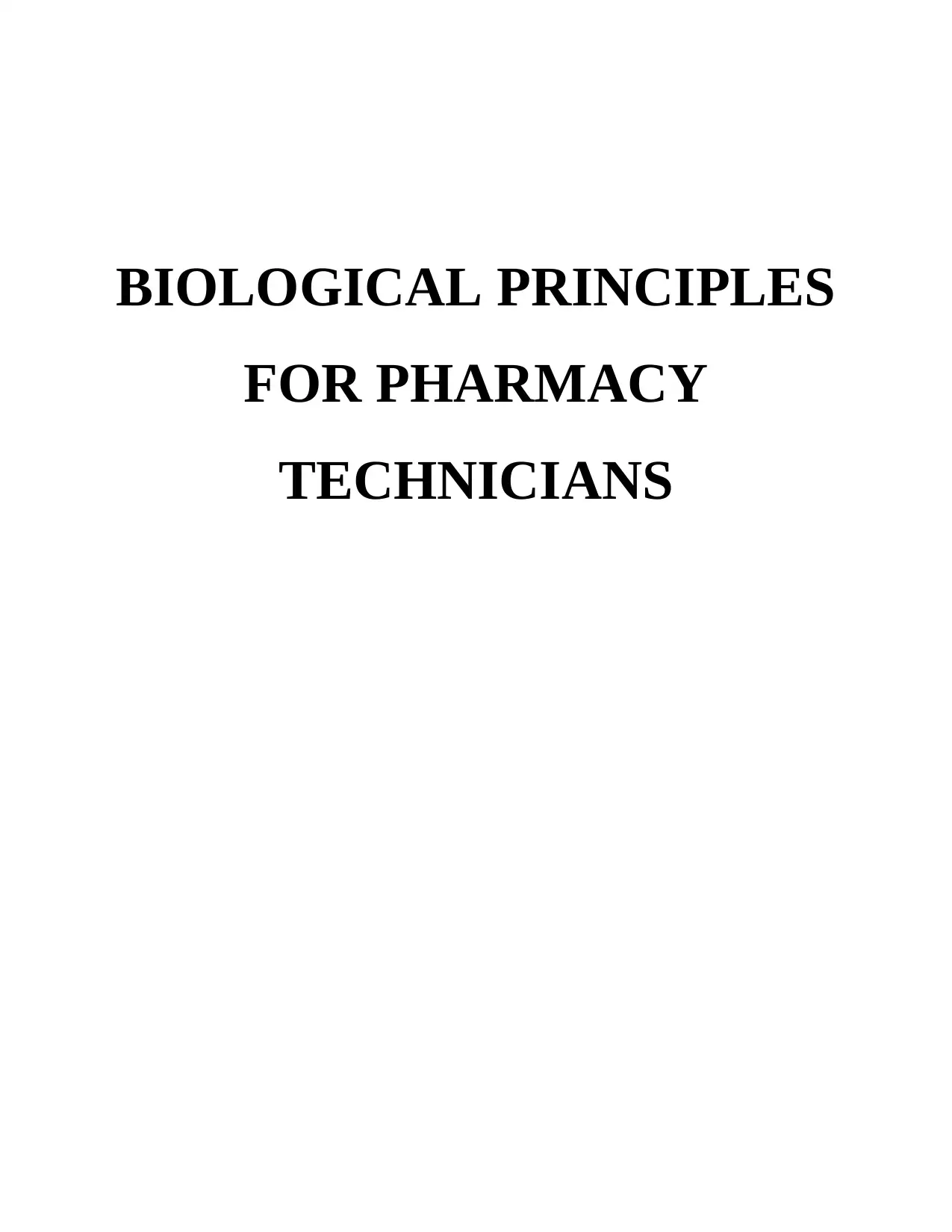
BIOLOGICAL PRINCIPLES
FOR PHARMACY
TECHNICIANS
FOR PHARMACY
TECHNICIANS
Paraphrase This Document
Need a fresh take? Get an instant paraphrase of this document with our AI Paraphraser
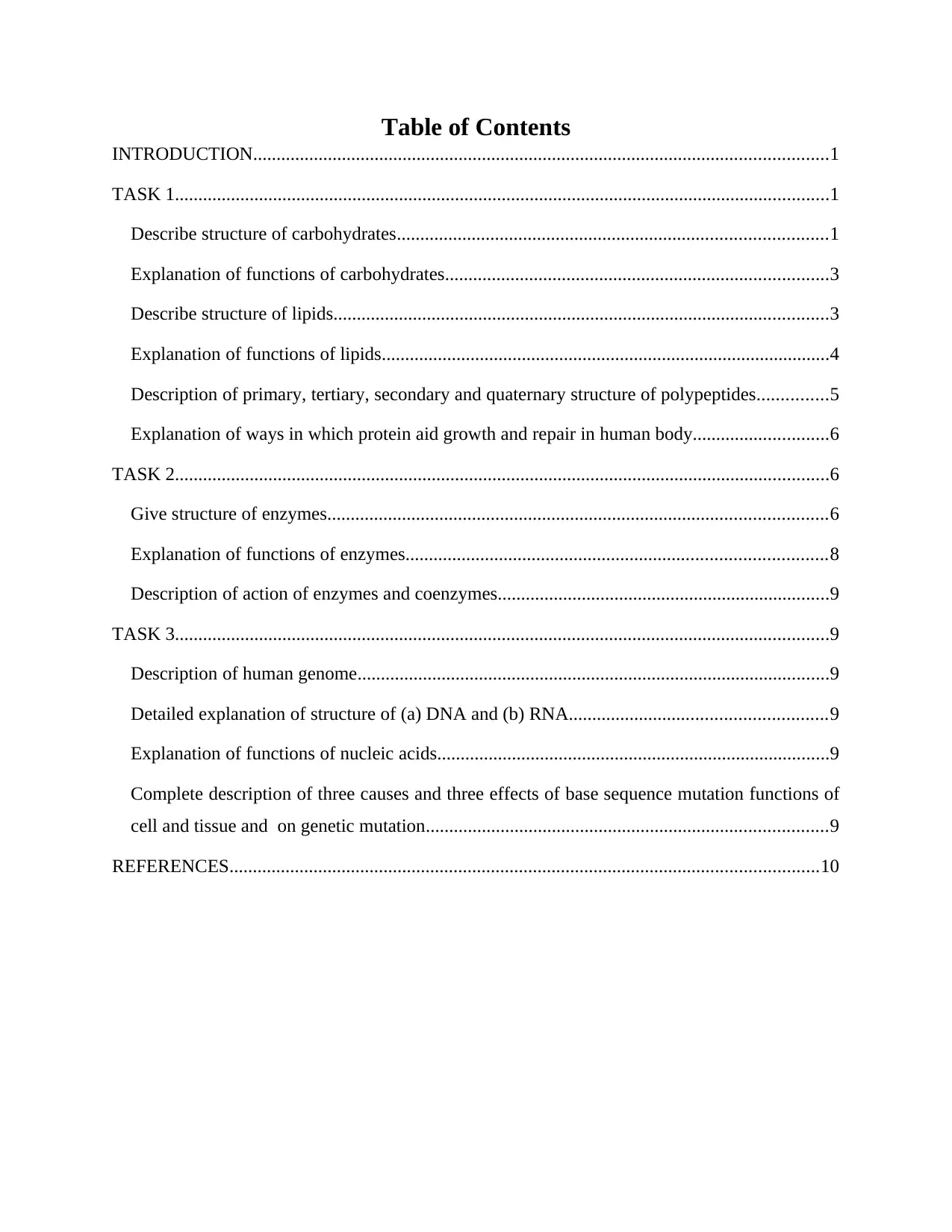
Table of Contents
INTRODUCTION...........................................................................................................................1
TASK 1............................................................................................................................................1
Describe structure of carbohydrates............................................................................................1
Explanation of functions of carbohydrates..................................................................................3
Describe structure of lipids..........................................................................................................3
Explanation of functions of lipids................................................................................................4
Description of primary, tertiary, secondary and quaternary structure of polypeptides...............5
Explanation of ways in which protein aid growth and repair in human body.............................6
TASK 2............................................................................................................................................6
Give structure of enzymes...........................................................................................................6
Explanation of functions of enzymes..........................................................................................8
Description of action of enzymes and coenzymes.......................................................................9
TASK 3............................................................................................................................................9
Description of human genome.....................................................................................................9
Detailed explanation of structure of (a) DNA and (b) RNA.......................................................9
Explanation of functions of nucleic acids....................................................................................9
Complete description of three causes and three effects of base sequence mutation functions of
cell and tissue and on genetic mutation......................................................................................9
REFERENCES..............................................................................................................................10
INTRODUCTION...........................................................................................................................1
TASK 1............................................................................................................................................1
Describe structure of carbohydrates............................................................................................1
Explanation of functions of carbohydrates..................................................................................3
Describe structure of lipids..........................................................................................................3
Explanation of functions of lipids................................................................................................4
Description of primary, tertiary, secondary and quaternary structure of polypeptides...............5
Explanation of ways in which protein aid growth and repair in human body.............................6
TASK 2............................................................................................................................................6
Give structure of enzymes...........................................................................................................6
Explanation of functions of enzymes..........................................................................................8
Description of action of enzymes and coenzymes.......................................................................9
TASK 3............................................................................................................................................9
Description of human genome.....................................................................................................9
Detailed explanation of structure of (a) DNA and (b) RNA.......................................................9
Explanation of functions of nucleic acids....................................................................................9
Complete description of three causes and three effects of base sequence mutation functions of
cell and tissue and on genetic mutation......................................................................................9
REFERENCES..............................................................................................................................10
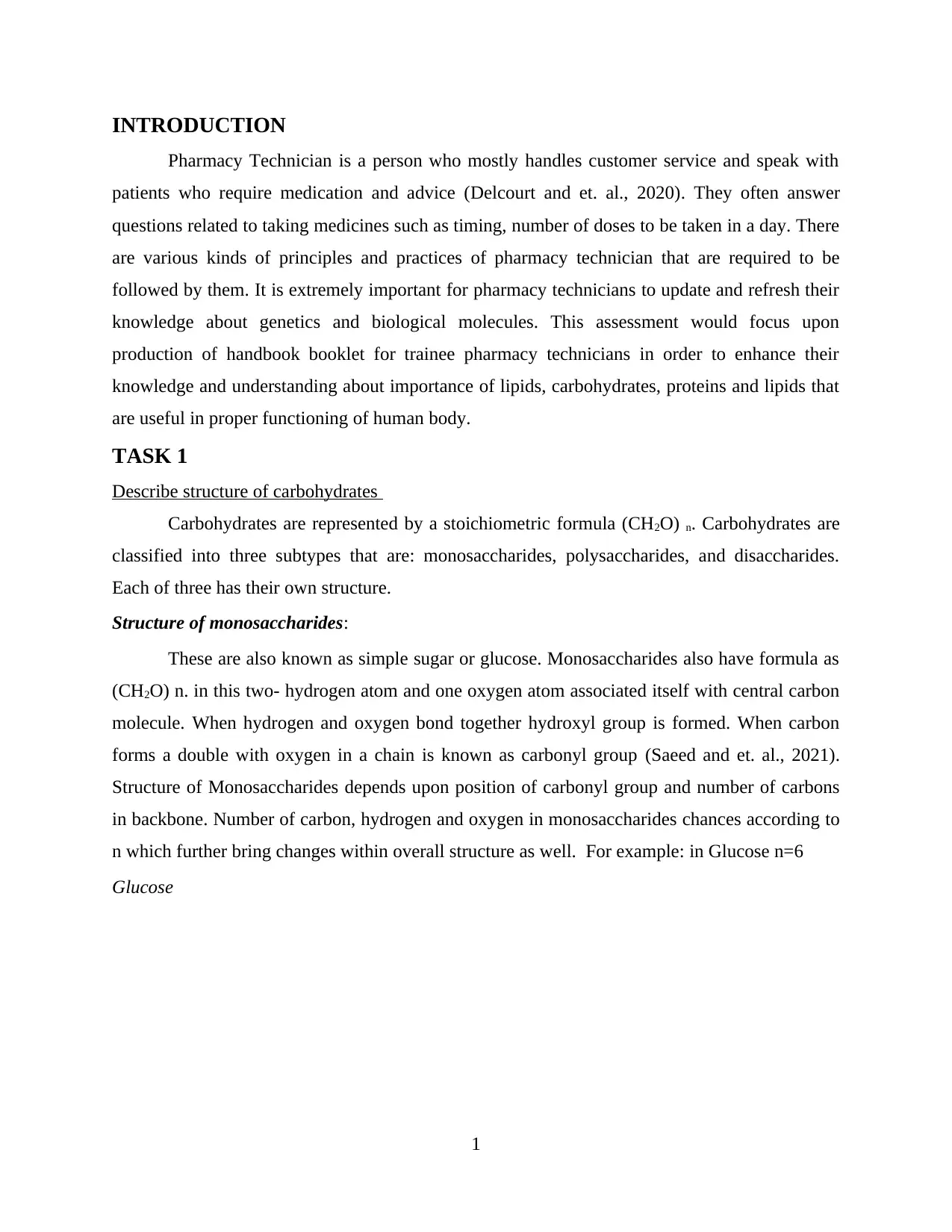
INTRODUCTION
Pharmacy Technician is a person who mostly handles customer service and speak with
patients who require medication and advice (Delcourt and et. al., 2020). They often answer
questions related to taking medicines such as timing, number of doses to be taken in a day. There
are various kinds of principles and practices of pharmacy technician that are required to be
followed by them. It is extremely important for pharmacy technicians to update and refresh their
knowledge about genetics and biological molecules. This assessment would focus upon
production of handbook booklet for trainee pharmacy technicians in order to enhance their
knowledge and understanding about importance of lipids, carbohydrates, proteins and lipids that
are useful in proper functioning of human body.
TASK 1
Describe structure of carbohydrates
Carbohydrates are represented by a stoichiometric formula (CH2O) n. Carbohydrates are
classified into three subtypes that are: monosaccharides, polysaccharides, and disaccharides.
Each of three has their own structure.
Structure of monosaccharides:
These are also known as simple sugar or glucose. Monosaccharides also have formula as
(CH2O) n. in this two- hydrogen atom and one oxygen atom associated itself with central carbon
molecule. When hydrogen and oxygen bond together hydroxyl group is formed. When carbon
forms a double with oxygen in a chain is known as carbonyl group (Saeed and et. al., 2021).
Structure of Monosaccharides depends upon position of carbonyl group and number of carbons
in backbone. Number of carbon, hydrogen and oxygen in monosaccharides chances according to
n which further bring changes within overall structure as well. For example: in Glucose n=6
Glucose
1
Pharmacy Technician is a person who mostly handles customer service and speak with
patients who require medication and advice (Delcourt and et. al., 2020). They often answer
questions related to taking medicines such as timing, number of doses to be taken in a day. There
are various kinds of principles and practices of pharmacy technician that are required to be
followed by them. It is extremely important for pharmacy technicians to update and refresh their
knowledge about genetics and biological molecules. This assessment would focus upon
production of handbook booklet for trainee pharmacy technicians in order to enhance their
knowledge and understanding about importance of lipids, carbohydrates, proteins and lipids that
are useful in proper functioning of human body.
TASK 1
Describe structure of carbohydrates
Carbohydrates are represented by a stoichiometric formula (CH2O) n. Carbohydrates are
classified into three subtypes that are: monosaccharides, polysaccharides, and disaccharides.
Each of three has their own structure.
Structure of monosaccharides:
These are also known as simple sugar or glucose. Monosaccharides also have formula as
(CH2O) n. in this two- hydrogen atom and one oxygen atom associated itself with central carbon
molecule. When hydrogen and oxygen bond together hydroxyl group is formed. When carbon
forms a double with oxygen in a chain is known as carbonyl group (Saeed and et. al., 2021).
Structure of Monosaccharides depends upon position of carbonyl group and number of carbons
in backbone. Number of carbon, hydrogen and oxygen in monosaccharides chances according to
n which further bring changes within overall structure as well. For example: in Glucose n=6
Glucose
1
⊘ This is a preview!⊘
Do you want full access?
Subscribe today to unlock all pages.

Trusted by 1+ million students worldwide
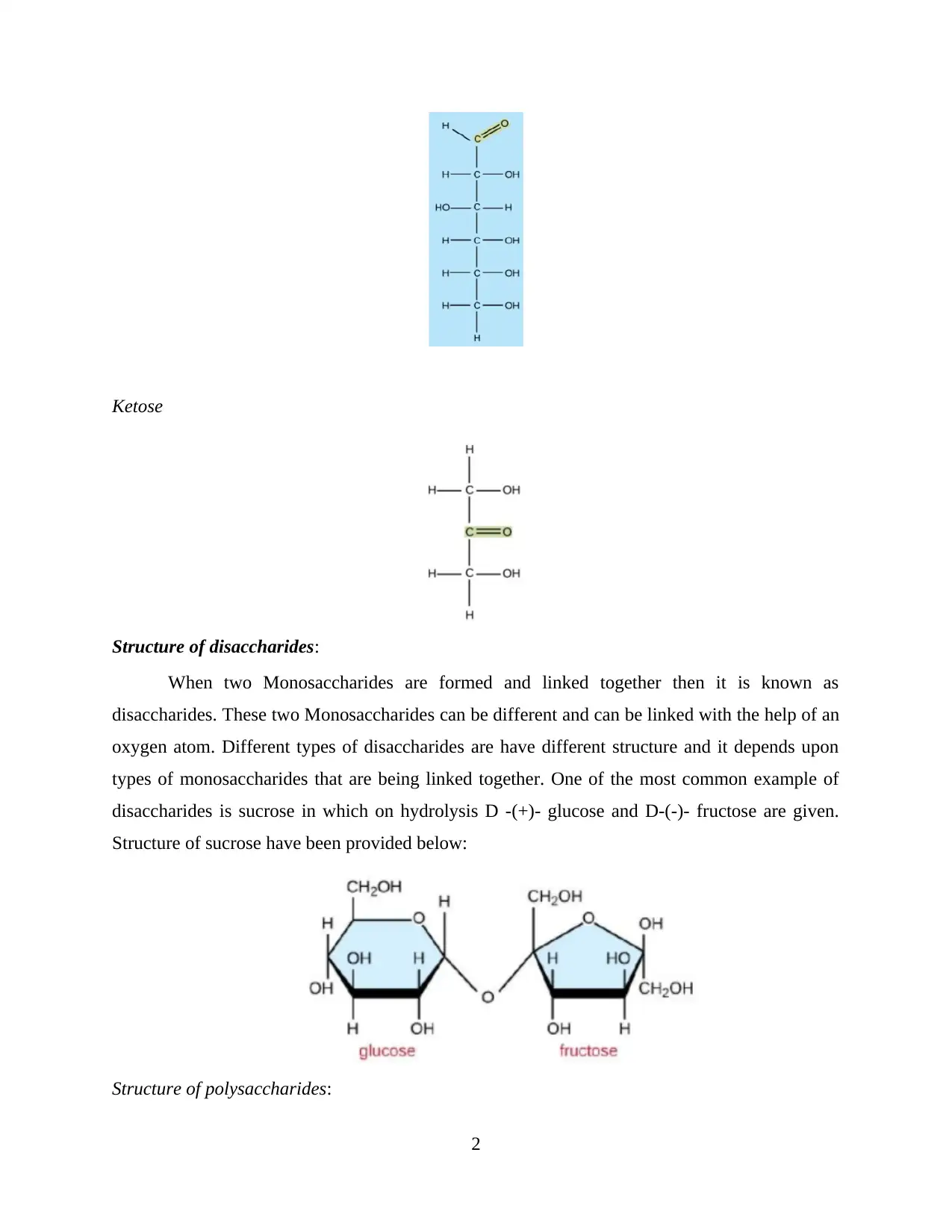
Ketose
Structure of disaccharides:
When two Monosaccharides are formed and linked together then it is known as
disaccharides. These two Monosaccharides can be different and can be linked with the help of an
oxygen atom. Different types of disaccharides are have different structure and it depends upon
types of monosaccharides that are being linked together. One of the most common example of
disaccharides is sucrose in which on hydrolysis D -(+)- glucose and D-(-)- fructose are given.
Structure of sucrose have been provided below:
Structure of polysaccharides:
2
Structure of disaccharides:
When two Monosaccharides are formed and linked together then it is known as
disaccharides. These two Monosaccharides can be different and can be linked with the help of an
oxygen atom. Different types of disaccharides are have different structure and it depends upon
types of monosaccharides that are being linked together. One of the most common example of
disaccharides is sucrose in which on hydrolysis D -(+)- glucose and D-(-)- fructose are given.
Structure of sucrose have been provided below:
Structure of polysaccharides:
2
Paraphrase This Document
Need a fresh take? Get an instant paraphrase of this document with our AI Paraphraser
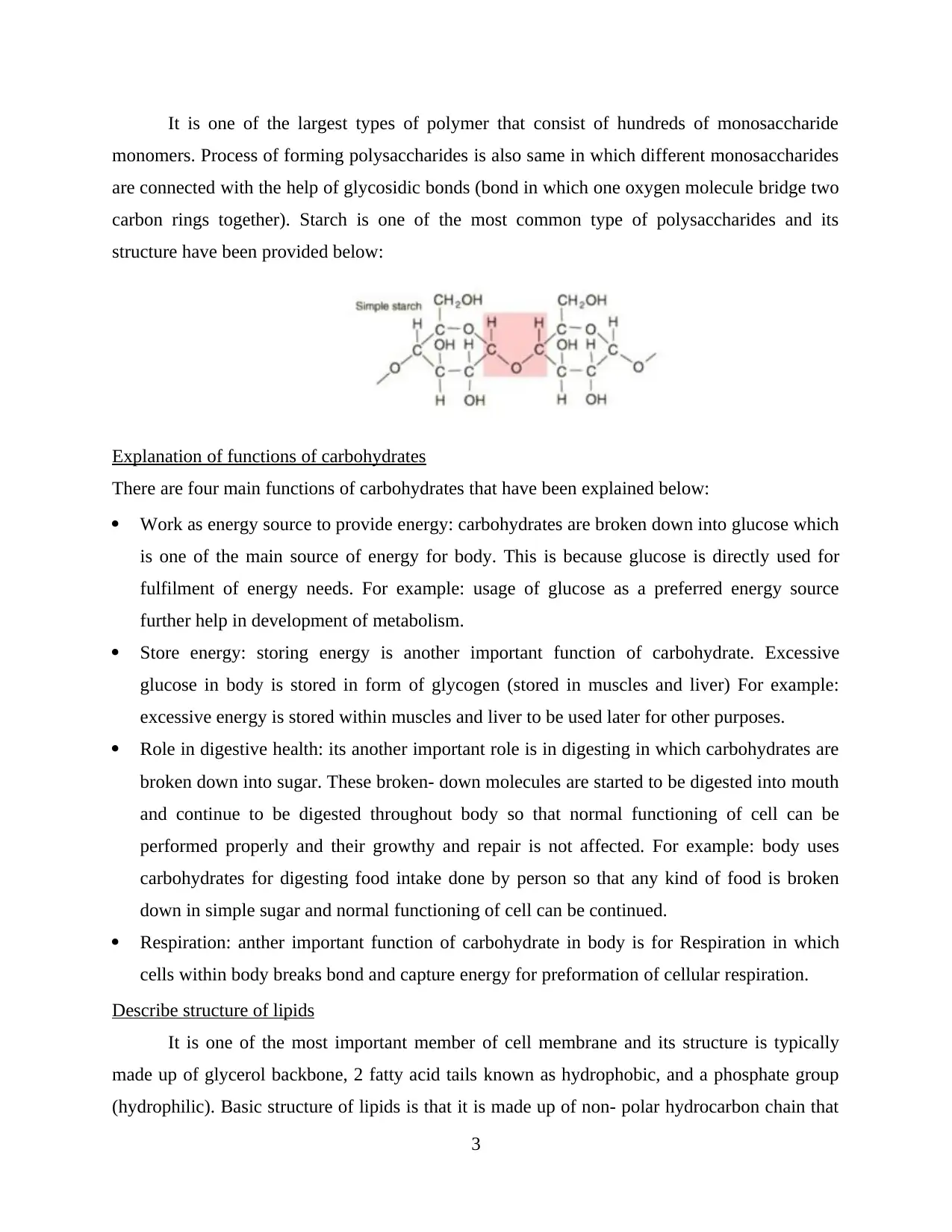
It is one of the largest types of polymer that consist of hundreds of monosaccharide
monomers. Process of forming polysaccharides is also same in which different monosaccharides
are connected with the help of glycosidic bonds (bond in which one oxygen molecule bridge two
carbon rings together). Starch is one of the most common type of polysaccharides and its
structure have been provided below:
Explanation of functions of carbohydrates
There are four main functions of carbohydrates that have been explained below:
Work as energy source to provide energy: carbohydrates are broken down into glucose which
is one of the main source of energy for body. This is because glucose is directly used for
fulfilment of energy needs. For example: usage of glucose as a preferred energy source
further help in development of metabolism.
Store energy: storing energy is another important function of carbohydrate. Excessive
glucose in body is stored in form of glycogen (stored in muscles and liver) For example:
excessive energy is stored within muscles and liver to be used later for other purposes.
Role in digestive health: its another important role is in digesting in which carbohydrates are
broken down into sugar. These broken- down molecules are started to be digested into mouth
and continue to be digested throughout body so that normal functioning of cell can be
performed properly and their growthy and repair is not affected. For example: body uses
carbohydrates for digesting food intake done by person so that any kind of food is broken
down in simple sugar and normal functioning of cell can be continued.
Respiration: anther important function of carbohydrate in body is for Respiration in which
cells within body breaks bond and capture energy for preformation of cellular respiration.
Describe structure of lipids
It is one of the most important member of cell membrane and its structure is typically
made up of glycerol backbone, 2 fatty acid tails known as hydrophobic, and a phosphate group
(hydrophilic). Basic structure of lipids is that it is made up of non- polar hydrocarbon chain that
3
monomers. Process of forming polysaccharides is also same in which different monosaccharides
are connected with the help of glycosidic bonds (bond in which one oxygen molecule bridge two
carbon rings together). Starch is one of the most common type of polysaccharides and its
structure have been provided below:
Explanation of functions of carbohydrates
There are four main functions of carbohydrates that have been explained below:
Work as energy source to provide energy: carbohydrates are broken down into glucose which
is one of the main source of energy for body. This is because glucose is directly used for
fulfilment of energy needs. For example: usage of glucose as a preferred energy source
further help in development of metabolism.
Store energy: storing energy is another important function of carbohydrate. Excessive
glucose in body is stored in form of glycogen (stored in muscles and liver) For example:
excessive energy is stored within muscles and liver to be used later for other purposes.
Role in digestive health: its another important role is in digesting in which carbohydrates are
broken down into sugar. These broken- down molecules are started to be digested into mouth
and continue to be digested throughout body so that normal functioning of cell can be
performed properly and their growthy and repair is not affected. For example: body uses
carbohydrates for digesting food intake done by person so that any kind of food is broken
down in simple sugar and normal functioning of cell can be continued.
Respiration: anther important function of carbohydrate in body is for Respiration in which
cells within body breaks bond and capture energy for preformation of cellular respiration.
Describe structure of lipids
It is one of the most important member of cell membrane and its structure is typically
made up of glycerol backbone, 2 fatty acid tails known as hydrophobic, and a phosphate group
(hydrophilic). Basic structure of lipids is that it is made up of non- polar hydrocarbon chain that
3
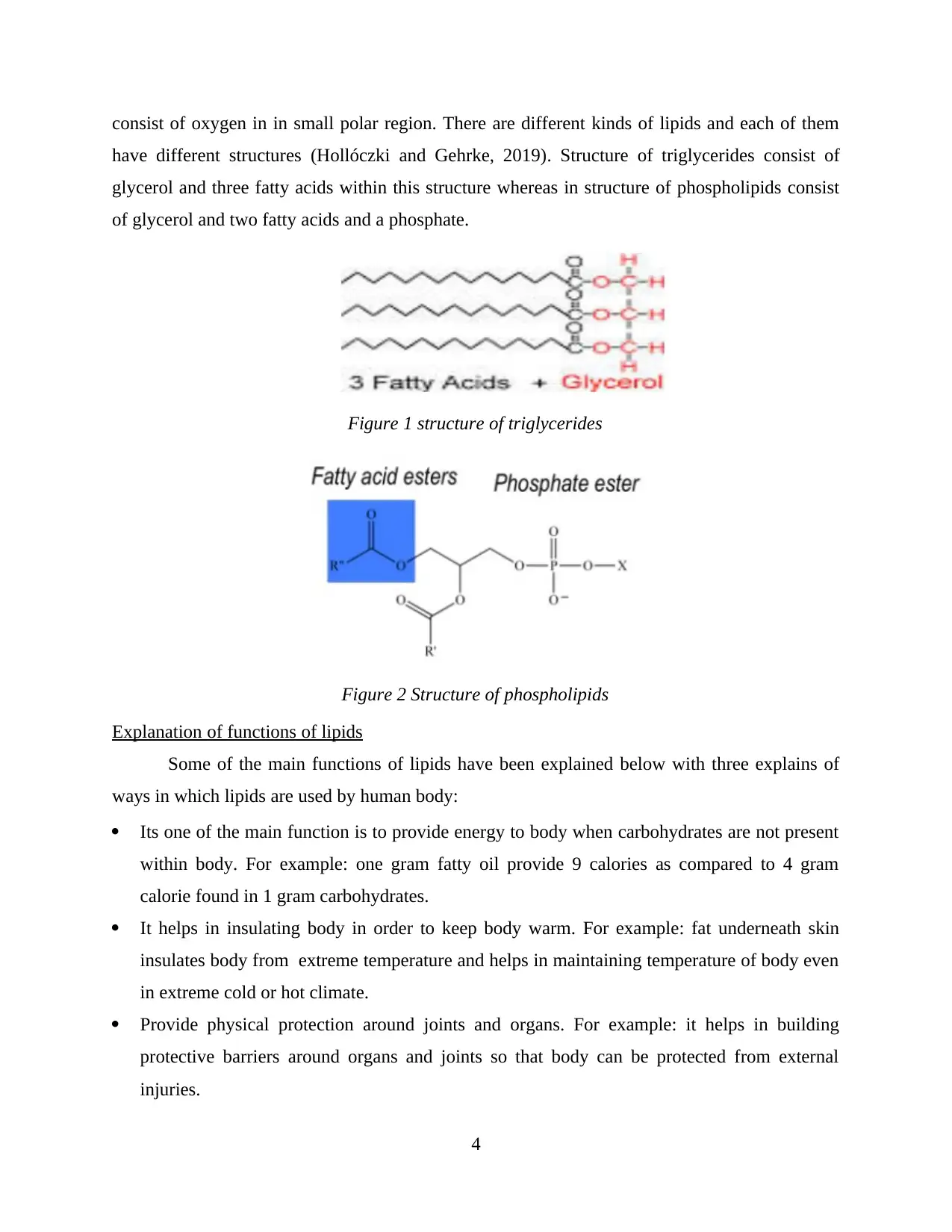
consist of oxygen in in small polar region. There are different kinds of lipids and each of them
have different structures (Hollóczki and Gehrke, 2019). Structure of triglycerides consist of
glycerol and three fatty acids within this structure whereas in structure of phospholipids consist
of glycerol and two fatty acids and a phosphate.
Figure 1 structure of triglycerides
Figure 2 Structure of phospholipids
Explanation of functions of lipids
Some of the main functions of lipids have been explained below with three explains of
ways in which lipids are used by human body:
Its one of the main function is to provide energy to body when carbohydrates are not present
within body. For example: one gram fatty oil provide 9 calories as compared to 4 gram
calorie found in 1 gram carbohydrates.
It helps in insulating body in order to keep body warm. For example: fat underneath skin
insulates body from extreme temperature and helps in maintaining temperature of body even
in extreme cold or hot climate.
Provide physical protection around joints and organs. For example: it helps in building
protective barriers around organs and joints so that body can be protected from external
injuries.
4
have different structures (Hollóczki and Gehrke, 2019). Structure of triglycerides consist of
glycerol and three fatty acids within this structure whereas in structure of phospholipids consist
of glycerol and two fatty acids and a phosphate.
Figure 1 structure of triglycerides
Figure 2 Structure of phospholipids
Explanation of functions of lipids
Some of the main functions of lipids have been explained below with three explains of
ways in which lipids are used by human body:
Its one of the main function is to provide energy to body when carbohydrates are not present
within body. For example: one gram fatty oil provide 9 calories as compared to 4 gram
calorie found in 1 gram carbohydrates.
It helps in insulating body in order to keep body warm. For example: fat underneath skin
insulates body from extreme temperature and helps in maintaining temperature of body even
in extreme cold or hot climate.
Provide physical protection around joints and organs. For example: it helps in building
protective barriers around organs and joints so that body can be protected from external
injuries.
4
⊘ This is a preview!⊘
Do you want full access?
Subscribe today to unlock all pages.

Trusted by 1+ million students worldwide

Description of primary, tertiary, secondary and quaternary structure of polypeptides
Structure of protein is a three dimensional structure and arrangement of atoms in amino-
acids chain molecule. There are four main types of protein structures and each of them vary from
each other.
Structure of primary polypeptides
It consist of amino acid sequence that further helps in driving folding and intramolecular
bonding of linear amino acid chain. In this amino acids are linked together to form a protein
(Kanagawa and Toda, 2018).
Structure of secondary polypeptides
It consists of a folding polypeptide chain that helps in giving it a 3-d shape. It is of two
types: first structure is alpha (α) helix structure and second is beta (β) pleated sheet structure.
Structure of tertiary polypeptides
It is a comprehensive 3-d structure of a polypeptide chain of a protein. In this there are
two main types of boding first is hydrophobic interactions and second is hydrogen bonding.
5
Structure of protein is a three dimensional structure and arrangement of atoms in amino-
acids chain molecule. There are four main types of protein structures and each of them vary from
each other.
Structure of primary polypeptides
It consist of amino acid sequence that further helps in driving folding and intramolecular
bonding of linear amino acid chain. In this amino acids are linked together to form a protein
(Kanagawa and Toda, 2018).
Structure of secondary polypeptides
It consists of a folding polypeptide chain that helps in giving it a 3-d shape. It is of two
types: first structure is alpha (α) helix structure and second is beta (β) pleated sheet structure.
Structure of tertiary polypeptides
It is a comprehensive 3-d structure of a polypeptide chain of a protein. In this there are
two main types of boding first is hydrophobic interactions and second is hydrogen bonding.
5
Paraphrase This Document
Need a fresh take? Get an instant paraphrase of this document with our AI Paraphraser

Structure of quaternary polypeptides
It is a structure of protein in which multiple polypeptide chains are interacted with each
other.
Explanation of ways in which protein aid growth and repair in human body
Protein provides and supply amino acids for growth and maintenance of cells and tissues
within a body. It is important because it helps in supporting cells so that they can be
consistently regenerated (Borase and et. al., 2020).
It further helps in healing of cells in an appropriate manner. it is important for repair of cells
in human. For example, after surgery protein helps in growth of tissues and cells in an
appropriate manner.
TASK 2
Give structure of enzymes
It is a linear chain of amino acids giving rise to three- dimensional structure. It is of three types
and each of its structure have been explained below:
Primary structure
6
It is a structure of protein in which multiple polypeptide chains are interacted with each
other.
Explanation of ways in which protein aid growth and repair in human body
Protein provides and supply amino acids for growth and maintenance of cells and tissues
within a body. It is important because it helps in supporting cells so that they can be
consistently regenerated (Borase and et. al., 2020).
It further helps in healing of cells in an appropriate manner. it is important for repair of cells
in human. For example, after surgery protein helps in growth of tissues and cells in an
appropriate manner.
TASK 2
Give structure of enzymes
It is a linear chain of amino acids giving rise to three- dimensional structure. It is of three types
and each of its structure have been explained below:
Primary structure
6
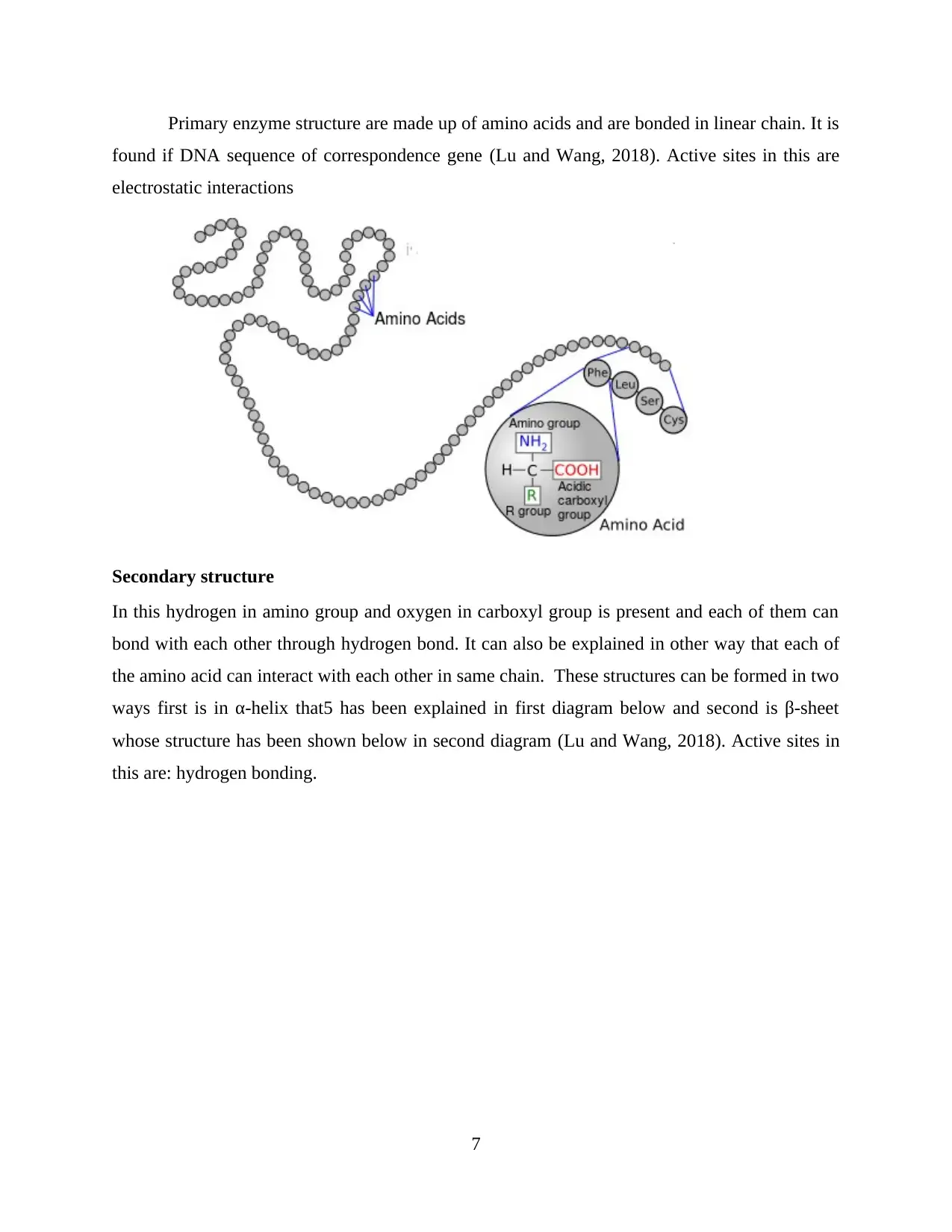
Primary enzyme structure are made up of amino acids and are bonded in linear chain. It is
found if DNA sequence of correspondence gene (Lu and Wang, 2018). Active sites in this are
electrostatic interactions
Secondary structure
In this hydrogen in amino group and oxygen in carboxyl group is present and each of them can
bond with each other through hydrogen bond. It can also be explained in other way that each of
the amino acid can interact with each other in same chain. These structures can be formed in two
ways first is in α-helix that5 has been explained in first diagram below and second is β-sheet
whose structure has been shown below in second diagram (Lu and Wang, 2018). Active sites in
this are: hydrogen bonding.
7
found if DNA sequence of correspondence gene (Lu and Wang, 2018). Active sites in this are
electrostatic interactions
Secondary structure
In this hydrogen in amino group and oxygen in carboxyl group is present and each of them can
bond with each other through hydrogen bond. It can also be explained in other way that each of
the amino acid can interact with each other in same chain. These structures can be formed in two
ways first is in α-helix that5 has been explained in first diagram below and second is β-sheet
whose structure has been shown below in second diagram (Lu and Wang, 2018). Active sites in
this are: hydrogen bonding.
7
⊘ This is a preview!⊘
Do you want full access?
Subscribe today to unlock all pages.

Trusted by 1+ million students worldwide
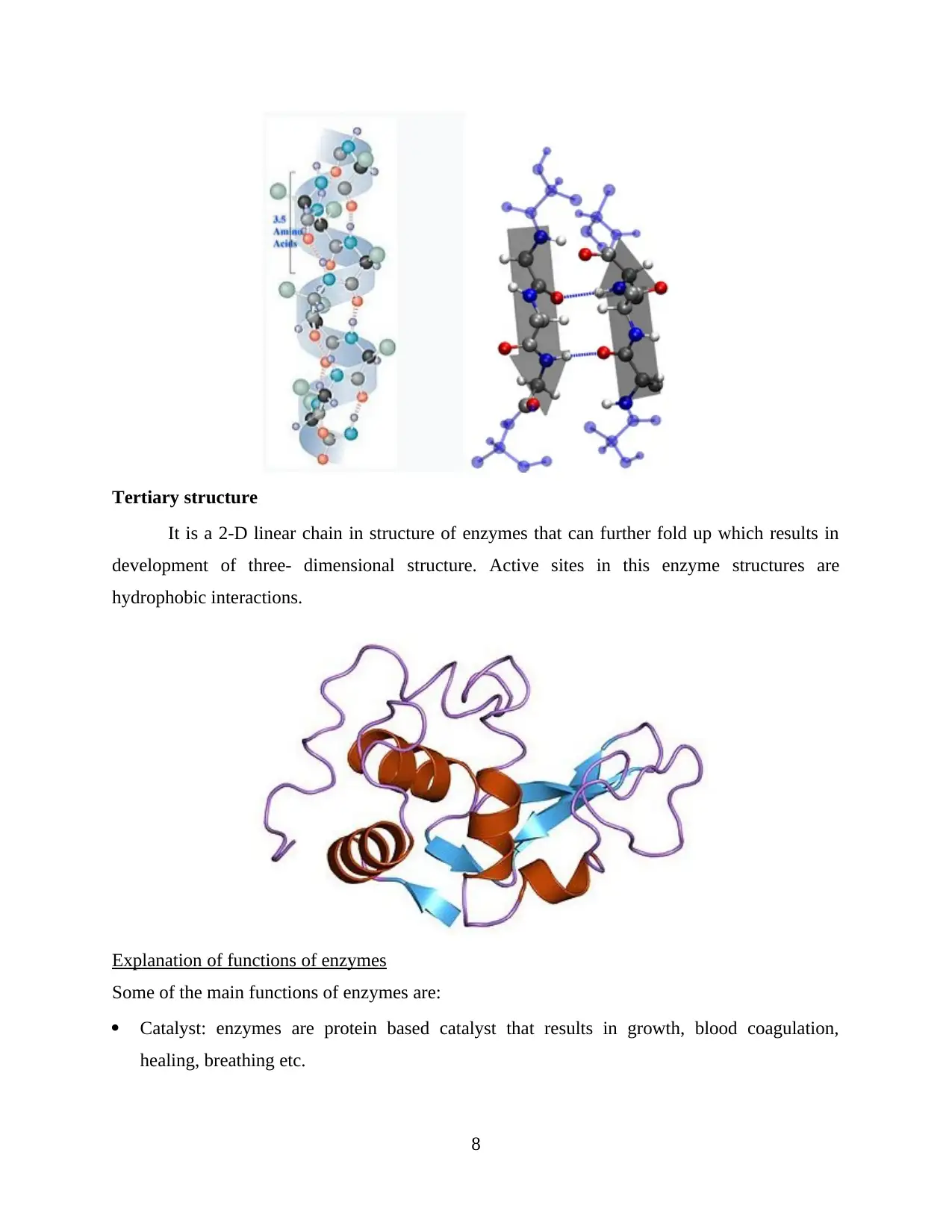
Tertiary structure
It is a 2-D linear chain in structure of enzymes that can further fold up which results in
development of three- dimensional structure. Active sites in this enzyme structures are
hydrophobic interactions.
Explanation of functions of enzymes
Some of the main functions of enzymes are:
Catalyst: enzymes are protein based catalyst that results in growth, blood coagulation,
healing, breathing etc.
8
It is a 2-D linear chain in structure of enzymes that can further fold up which results in
development of three- dimensional structure. Active sites in this enzyme structures are
hydrophobic interactions.
Explanation of functions of enzymes
Some of the main functions of enzymes are:
Catalyst: enzymes are protein based catalyst that results in growth, blood coagulation,
healing, breathing etc.
8
Paraphrase This Document
Need a fresh take? Get an instant paraphrase of this document with our AI Paraphraser

Inhibitor: presence of inhibitor helps in changing shape it is extremely essential for digestion
of food within body and can further help in preventing health problem of active sites that
further prevent rate of reaction within body.
Activator: it further helps in increasing velocity of enzymatic reactions.
Description of action of enzymes and coenzymes
TASK 3
Description of human genome
Detailed explanation of structure of (a) DNA and (b) RNA
Explanation of functions of nucleic acids
Complete description of three causes and three effects of base sequence mutation functions of
cell and tissue and on genetic mutation
9
of food within body and can further help in preventing health problem of active sites that
further prevent rate of reaction within body.
Activator: it further helps in increasing velocity of enzymatic reactions.
Description of action of enzymes and coenzymes
TASK 3
Description of human genome
Detailed explanation of structure of (a) DNA and (b) RNA
Explanation of functions of nucleic acids
Complete description of three causes and three effects of base sequence mutation functions of
cell and tissue and on genetic mutation
9
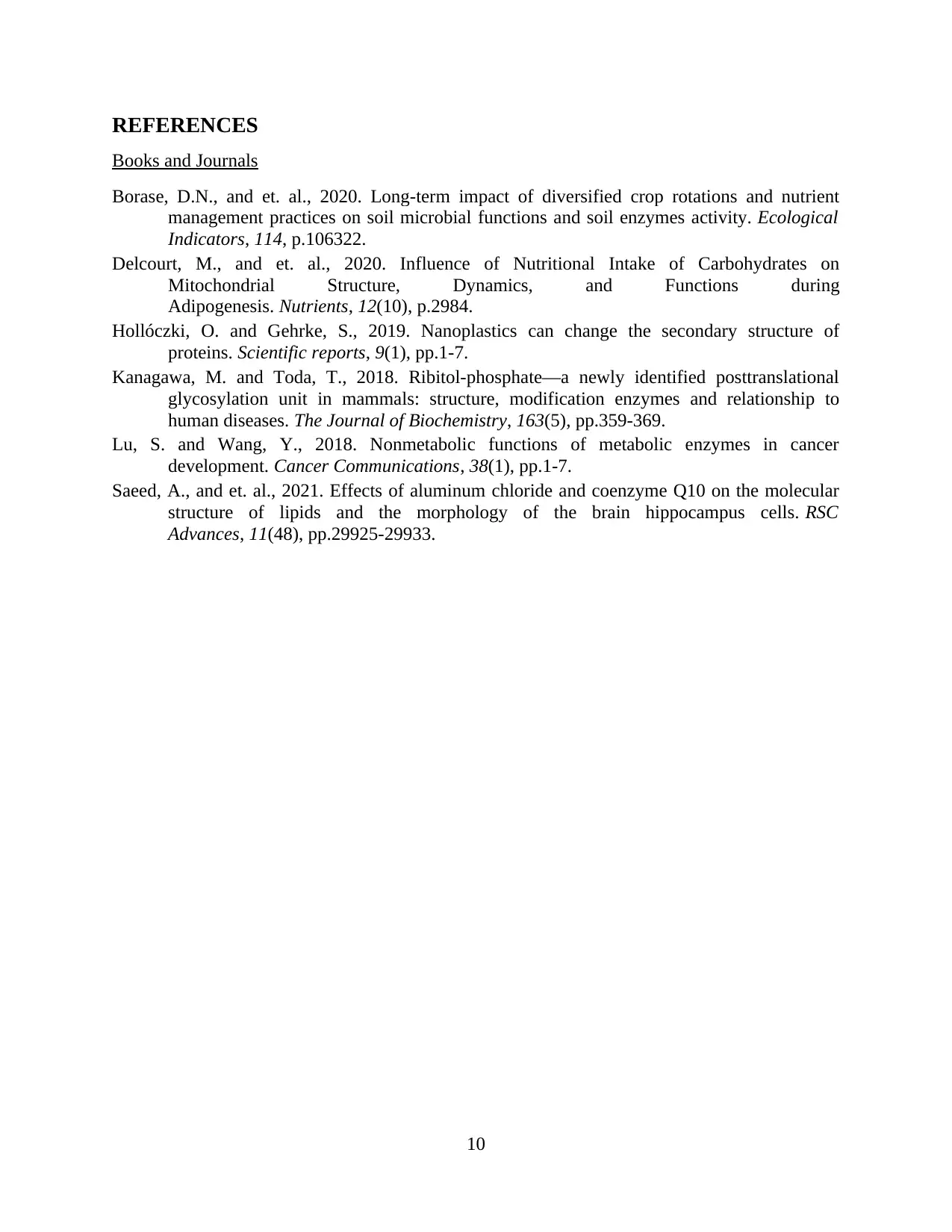
REFERENCES
Books and Journals
Borase, D.N., and et. al., 2020. Long-term impact of diversified crop rotations and nutrient
management practices on soil microbial functions and soil enzymes activity. Ecological
Indicators, 114, p.106322.
Delcourt, M., and et. al., 2020. Influence of Nutritional Intake of Carbohydrates on
Mitochondrial Structure, Dynamics, and Functions during
Adipogenesis. Nutrients, 12(10), p.2984.
Hollóczki, O. and Gehrke, S., 2019. Nanoplastics can change the secondary structure of
proteins. Scientific reports, 9(1), pp.1-7.
Kanagawa, M. and Toda, T., 2018. Ribitol-phosphate—a newly identified posttranslational
glycosylation unit in mammals: structure, modification enzymes and relationship to
human diseases. The Journal of Biochemistry, 163(5), pp.359-369.
Lu, S. and Wang, Y., 2018. Nonmetabolic functions of metabolic enzymes in cancer
development. Cancer Communications, 38(1), pp.1-7.
Saeed, A., and et. al., 2021. Effects of aluminum chloride and coenzyme Q10 on the molecular
structure of lipids and the morphology of the brain hippocampus cells. RSC
Advances, 11(48), pp.29925-29933.
10
Books and Journals
Borase, D.N., and et. al., 2020. Long-term impact of diversified crop rotations and nutrient
management practices on soil microbial functions and soil enzymes activity. Ecological
Indicators, 114, p.106322.
Delcourt, M., and et. al., 2020. Influence of Nutritional Intake of Carbohydrates on
Mitochondrial Structure, Dynamics, and Functions during
Adipogenesis. Nutrients, 12(10), p.2984.
Hollóczki, O. and Gehrke, S., 2019. Nanoplastics can change the secondary structure of
proteins. Scientific reports, 9(1), pp.1-7.
Kanagawa, M. and Toda, T., 2018. Ribitol-phosphate—a newly identified posttranslational
glycosylation unit in mammals: structure, modification enzymes and relationship to
human diseases. The Journal of Biochemistry, 163(5), pp.359-369.
Lu, S. and Wang, Y., 2018. Nonmetabolic functions of metabolic enzymes in cancer
development. Cancer Communications, 38(1), pp.1-7.
Saeed, A., and et. al., 2021. Effects of aluminum chloride and coenzyme Q10 on the molecular
structure of lipids and the morphology of the brain hippocampus cells. RSC
Advances, 11(48), pp.29925-29933.
10
⊘ This is a preview!⊘
Do you want full access?
Subscribe today to unlock all pages.

Trusted by 1+ million students worldwide
1 out of 12
Related Documents
Your All-in-One AI-Powered Toolkit for Academic Success.
+13062052269
info@desklib.com
Available 24*7 on WhatsApp / Email
![[object Object]](/_next/static/media/star-bottom.7253800d.svg)
Unlock your academic potential
Copyright © 2020–2025 A2Z Services. All Rights Reserved. Developed and managed by ZUCOL.


![Analysis of Carbohydrates in Human Body: Biology Report, [Date]](/_next/image/?url=https%3A%2F%2Fdesklib.com%2Fmedia%2Fimages%2Fnh%2F7b5ea273413144b985b8efdebb047dc4.jpg&w=256&q=75)


